Cal Bank offered the cheapest lending rate of 15.97% in the banking industry, according to the Average Lending Rates of universal banks, published by the Bank of Ghana as of the end of July this year.
The listed bank per the figures from the Bank of Ghana offers lending rate lower than the regulator’s Reference Rate.
However, credit worthy clients will enjoy cost of credit lower than the 15.97%, but those considered as high risk will pay more interest for the loans acquired from the bank.
In 2nd place is Guaranty Trust Bank with an average cost of credit of 16.97%. Closely following GT Bank in third position is Bank of Africa with lending rate of 17.19%.
OmniBSIC and Ecobank Ghana were ranked 4th and 5th respectively with average lending rates of 17.95% and 18.41% respectively.
The Bank of Ghana’s policy rate presently stands at 14.5%. So these banks offered interest rates on loans of between 1.47 and 3.91 percentage points higher than the Central Bank’s base lending rate.
This means the spread between the policy rate and their average lending rates make reasonable sense. 14 out of the 23 banks offered lending rates of more than 20%.
Agricultural Development Bank rate of 24.89% was the highest in the banking industry.
It is followed by Societe Generale and Absa Bank with average lending rates of 23.61% and 23.59% respectively.
In conclusion, the Bank of Ghana said the publication of the rates is to help promote transparency in the pricing of loans by the universal banks.
Cost of loans fall further, as average lending rate pegged at 20.61% – BoG
Cost of loans continued to fall but marginally, as average lending rate stood at 20.61% per annum in June this year.
This was equivalent to 1.72% interest on loans per month.
However, the average lending rate varied among the banks and the respective sectors.
For instance, some banks offered loans as low as 17% per annum, whilst others charge rates as high as 27%. Overall, it depends on the risk profile of the customers.
Also, lending to the agriculture sector is considered riskier than the manufacturing sector, and therefore credit to the agriculture sector will be higher.
Latest Stories
-
Navrongo traditional leaders urge Mahama to intervene in looming chieftaincy crisis
32 minutes -
Iran–Israel war: Dissecting Netanyahu’s political calculus
35 minutes -
When Algeria came to Iran’s aid
48 minutes -
‘Retired but not tired’ – Stakeholders celebrate COP Samuel Alfred Winful’s distinguished service
1 hour -
GWCL official dismisses claims of sabotage over uncommissioned Broto Water Project
1 hour -
Pakistan to nominate Trump for Nobel Peace Prize
2 hours -
Suicide bombing at Damascus church kills 22, Syrian authorities say
3 hours -
Bellingham scores as 10-man Real Madrid beat Pachuca
3 hours -
Three fans die in Algeria football stadium fall
3 hours -
South African engineers freed after two years in Equatorial Guinea jail
3 hours -
FedEx founder and former boss Fred Smith dies aged 80
3 hours -
Bride shot dead in attack on French wedding party
4 hours -
Legon Cities handed transfer ban over unpaid GHC 29,000 compensation to Francis Addo
4 hours -
Alonso says FIFA investigating racial abuse against Rudiger
4 hours -
Rashford would like to play at Barcelona with Yamal
4 hours

